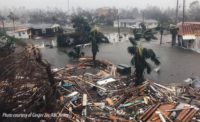Natural Catastrophes Account for $40 Billion in Economic Losses in First Half of 2019

Global economic losses from natural catastrophes and man-made disasters in the first half of 2019 amounted to $44 billion, according to Swiss Re Institute's preliminary sigma estimates.
The figure is well below $109 billion, the average first-half economic losses of the previous 10 years. It is also lower than the losses of $51 billion reported for the same period a year earlier. Of the total global economic losses in the first half of 2019, $19 billion were covered by insurance, the main driver being thunderstorms and flooding events in different parts of the world. More than 5,000 people lost their lives or went missing in disaster events during the period.
Of the $44 billion in total global economic losses, natural catastrophes accounted for the majority, or $40 billion in the first half of 2019, compared with $45 billion in the year-earlier period. The remaining $4 billion of losses were caused by man-made disasters. Global insured losses from natural catastrophes fell to $15 billion from $21 billion the year before, while insured losses from man-made disasters decreased to $4 billion from $5 billion.
Only about 42 percent of the global economic losses were insured (compared with 52 percent in the first half of 2018) as several large-scale disaster events, such as cyclone Idai in southern Africa and cyclone Fani in India, occurred in areas with low insurance penetration. Cyclone Idai, which caused strong winds and severe flooding across Mozambique, Malawi, Zimbabwe and Madagascar, was the deadliest natural catastrophe in the first half of this year, claiming more than 1,000 victims. Economic losses from cyclone Idai are estimated at least at $2 billion, of which only about seven percent were insured.
Secondary perils such as thunderstorms, torrential rains and snowmelt caused the highest losses through wind and water damage in the first half of 2019 in many regions of the world, including the U.S., Canada, Europe, Australia, China and Iran. Swiss Re Institute's sigma estimates the total economic losses of these events at $32 billion. Approximately $13 billion of the losses were insured.
As in the first half of 2018, several parts of the world also experienced heatwaves and dry weather conditions this year, with temperature records broken in several locations, particularly in Europe. The full impact of the extreme summer weather is yet to be determined.
Looking for a reprint of this article?
From high-res PDFs to custom plaques, order your copy today!





